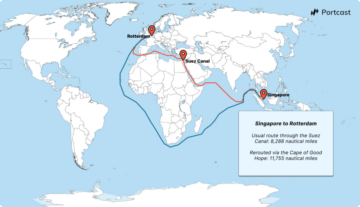
Find out why the recent Colonial Pipeline cyberattack reinforces the need for modeling and creating a digital twin of a supply chain, which can go a long way in planning for uncertainty.
On May 7, 2021, Colonial Pipeline was hacked. The pipeline immediately shut down and backed up crude oil and refined products before the company could finally restore the pipeline system. The cybersecurity incident highlights just how fragile the energy supply chain is when unexpected disruptions like these occur.
Two Roads Diverged
As Robert Frost famously wrote, “two roads diverged in a yellow wood, and sorry I could not travel both…I took the one less traveled by, and that has made all the difference.” In this case, a company can maintain the status quo and only sometimes plan on a quarterly basis. Or, better yet, a company can digest the fact that instability is the new norm.
Take the time to model and create a digital twin of your supply chain. Leverage any one of several solutions on the market. With the digital twin created, focus the organization and culture on constant planning. What’s the optimal path to market? What if that norm changes unexpectedly? What if demand skyrockets? What if we lose a “guaranteed” supply?
Learn From The (Recent) Past Or You’re Doomed To Repeat It
Use the shock of the Colonial Pipeline as an impetus to rethink your supply chain. Turn old norms on their head about what’s “stable”. Bring in fresh ideas and rethink each piece along the way. The only constant in today’s world is that we’ll always be faced with challenges in a rapidly changing world.
It’s important to act, and start defining your supply chain (if not known) and then build out a full supply chain digital twin. In doing so, companies can then incorporate critical factors that drive optimization such as historical sales patterns, weather adjustments, or other economic indicators for each market. The supply side models the realism of inventory targets/constraints, purchase and sale deal constraints, multi-modal logistics costs, and transit times. Once modeled, then tie the results to trading and transportation dispatch systems to improve the speed by which the tool can direct real-world movements. Keep in mind that models always need to be maintained and tweaked to reflect the ever-changing reality of the world around us.
So, unless you can convince your closest 100,000+ friends not to assume irrational behavior at the drop of a hat or after reading the latest blog posting in your mother’s Facebook group, you better prepare your organization for the next unexpected disturbance. Whether it’s toilet paper, ketchup, or gasoline, you need to be ready and plan for uncertainty in today’s new world.
The Delicate Balance of Getting Product to Market
Many people don’t think about how gasoline gets to gas stations. We take it for granted that it’ll be available whenever we drive up to the corner station and fill up. Depending on your commute and usage, that could be once, twice, or maybe multiple times each week. What caused the shortage of gasoline was not a lack of product. There’s plenty of gasoline. The problem is rooted in how the supply chain is structured.
Suffice to say that it’s purposefully fragmented. Each actor depends on the tight integration and handoff all along the way from the refinery to pipelines to storage to trucks to your local gas station. And, in today’s world that values itself on razor margin, there is almost zero room for error. Buffers in the supply chain are expensive.
Minimize Costs & Optimize
The mantra over the years has been to cut costs out of companies to reduce inventories. This means that companies need to replenish their goods sold more frequently. They must “listen” to signals from customers and order the appropriate lot sizes to maintain products. Nothing is worse than going to the store for redeeming a coupon for a sale and realizing there are no more products available. It costs money to hold and carry inventory. Therefore, companies only carry small buffers. They’re not incented to carry large stocks. Investors want inventory turns; not product sitting idly on “shelves.”
How We Got To 1970s-Style Gas Lines
The problem facing the Southeast and Mid-Atlantic isn’t unique for gas shortages. Essentially, gas stations have set schedules for re-orders and replenishments. Smart people in back rooms compute average demand, inventory levels, safety stock, transit time, and then determine the frequency of replenishing. That all works so long as each factor is predictable.
In the case of the hacked pipeline, people feared that gasoline would run out. So, they did what any mindless mass would do—horde gasoline and buy more than was needed. Suddenly, there’s “noise” given off by quickly draining the inventory available. If companies aren’t observant, they miss the new signal and run out of product. Or, in the case of many of the gas stations, they’re observant but cannot act quickly enough to truck in deliveries.
Remember The Great Toilet Paper Shortage Of 2020?
People are rational (mostly). However, crowds and populations feed off rumors and the speed of misinformation on the Internet. At the outset of the COVID-19 pandemic in early 2020, we were told to hunker down in our homes and keep our distance from other people. Instantaneously, toilet paper flew off store shelves because social media and mass media hysteria drove consumer behavior.
In the case of the Colonial Pipeline shutdown, someone posts that one gas station is out. Now panic ensues as people scramble to get the next gallon of gas—never mind that they don’t have any extra need for gasoline. Did driving patterns change radically? Was there suddenly a need for more vacations and trips out of town? No, this is just hysteria, fed by the media driving false demand. It doesn’t matter if it’s toilet paper or gasoline. Irrationality takes no prisoners as it sows chaos in planning models.
‘I Told You So’ Doesn’t Work When You Really Need Fuel
So, we’re here in the middle of a crisis. As I write this, Colonial Pipeline is slowly coming back online and will move as much product out of the areas of supply and to the areas of demand. Will companies learn from this?
The smart ones should. As much as we crave normalcy and stability, companies need to recognize that the world is anything but normal or stable these days. Anyone remember the “Great Lock Down of 2020” when no one was driving, and the world came to a standstill? Guess what that did for production planning?
About the Author
Patrick Long is a Director in Opportune LLP’s Process & Technology practice. Patrick has over 20 years of experience in providing clients with energy trading and risk management, packaged software implementation, trading and risk processes and business process automation. Patrick focuses his time on studying supply chain issues and implementing digital twins. He helps transform capabilities from non-existent to best of breed solutions. His current focus for clients is making sense of inventory and the supply chain to address management questions. He enjoys thinking of ways to thwart irrational human behavior and its effects on optimization. Prior to joining Opportune, Patrick worked in the energy consulting trading and risk systems practice at Accenture where he managed project teams through the entire process of software selection to successful implementation of trading and risk management systems for energy trading entities.
- &
- 100
- 2020
- 2021
- 7
- Accenture
- All
- around
- Automation
- BEST
- Blog
- build
- business
- Business Process Automation
- buy
- caused
- change
- clients
- coming
- Commute
- Companies
- company
- Compute
- consulting
- consumer
- consumer behavior
- Costs
- COVID-19
- COVID-19 pandemic
- Creating
- crisis
- Culture
- Current
- Customers
- Cyberattack
- Cybersecurity
- deal
- Deliveries
- Demand
- DID
- digital
- digital twin
- Digital twins
- Director
- Dispatch
- distance
- driving
- Drop
- Early
- Economic
- energy
- facing
- Fed
- Finally
- Focus
- fresh
- full
- GAS
- goods
- great
- Group
- head
- here
- hold
- How
- HTTPS
- integration
- Internet
- inventory
- Investors
- issues
- IT
- large
- latest
- LEARN
- Leverage
- local
- logistics
- Long
- Making
- management
- Mantra
- Market
- mass media
- Media
- Misinformation
- model
- modeling
- money
- move
- Oil
- order
- Other
- pandemic
- Panic
- Paper
- People
- planning
- Plenty
- Posts
- Process Automation
- Product
- Production
- Products
- project
- purchase
- Reading
- Reality
- reduce
- Results
- Risk
- risk management
- roads
- ROBERT
- Rooms
- Rumors
- Run
- Safety
- sale
- sales
- sense
- set
- shortages
- shutdown
- small
- smart
- So
- Social
- social media
- Software
- sold
- Solutions
- speed
- Stability
- start
- Status
- stock
- Stocks
- storage
- store
- successful
- supply
- supply chain
- system
- Systems
- Thinking
- TIE
- time
- Toilet
- Trading
- transit
- transportation
- travel
- truck
- Trucks
- us
- week
- Work
- works
- world
- Yahoo
- years
- zero










